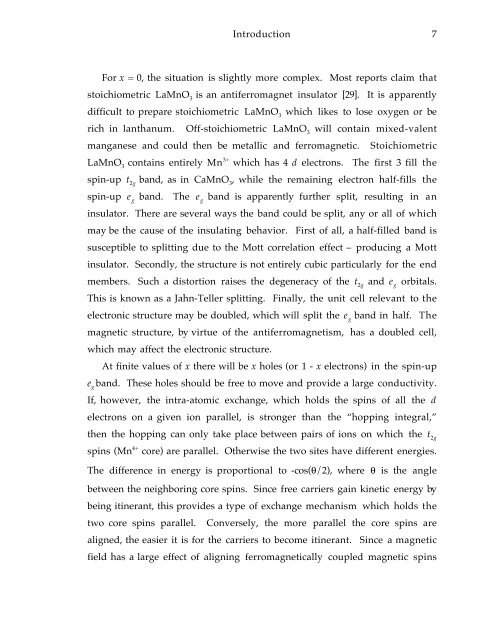MAGNETISM ELECTRON TRANSPORT MAGNETORESISTIVE LANTHANUM CALCIUM MANGANITE
MAGNETISM ELECTRON TRANSPORT MAGNETORESISTIVE LANTHANUM CALCIUM MANGANITE
MAGNETISM ELECTRON TRANSPORT MAGNETORESISTIVE LANTHANUM CALCIUM MANGANITE
Create successful ePaper yourself
Turn your PDF publications into a flip-book with our unique Google optimized e-Paper software.
Introduction 7<br />
For x = 0, the situation is slightly more complex. Most reports claim that<br />
stoichiometric LaMnO 3 is an antiferromagnet insulator [29]. It is apparently<br />
difficult to prepare stoichiometric LaMnO 3 which likes to lose oxygen or be<br />
rich in lanthanum. Off-stoichiometric LaMnO 3 will contain mixed-valent<br />
manganese and could then be metallic and ferromagnetic. Stoichiometric<br />
LaMnO 3 contains entirely Mn 3+ which has 4 d electrons. The first 3 fill the<br />
spin-up t 2g band, as in CaMnO 3 , while the remaining electron half-fills the<br />
spin-up e g band. The e g band is apparently further split, resulting in an<br />
insulator. There are several ways the band could be split, any or all of which<br />
may be the cause of the insulating behavior. First of all, a half-filled band is<br />
susceptible to splitting due to the Mott correlation effect Ð producing a Mott<br />
insulator. Secondly, the structure is not entirely cubic particularly for the end<br />
members. Such a distortion raises the degeneracy of the t 2g and e g orbitals.<br />
This is known as a Jahn-Teller splitting. Finally, the unit cell relevant to the<br />
electronic structure may be doubled, which will split the e g band in half. The<br />
magnetic structure, by virtue of the antiferromagnetism, has a doubled cell,<br />
which may affect the electronic structure.<br />
At finite values of x there will be x holes (or 1 - x electrons) in the spin-up<br />
e g band. These holes should be free to move and provide a large conductivity.<br />
If, however, the intra-atomic exchange, which holds the spins of all the d<br />
electrons on a given ion parallel, is stronger than the Òhopping integral,Ó<br />
then the hopping can only take place between pairs of ions on which the t 2g<br />
spins (Mn 4+ core) are parallel. Otherwise the two sites have different energies.<br />
The difference in energy is proportional to -cos(θ/2), where θ is the angle<br />
between the neighboring core spins. Since free carriers gain kinetic energy by<br />
being itinerant, this provides a type of exchange mechanism which holds the<br />
two core spins parallel. Conversely, the more parallel the core spins are<br />
aligned, the easier it is for the carriers to become itinerant. Since a magnetic<br />
field has a large effect of aligning ferromagnetically coupled magnetic spins
















